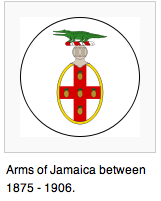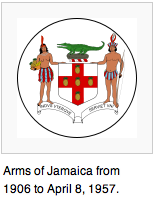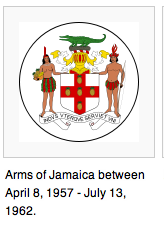Jamaica's Coat of Arms: A Symbol of Heritage and Unity
 Main Street Rose Hall
Main Street Rose Hall- Jul 22, 2024
- 5 min read
Updated: Oct 30, 2024
The coat of arms is an emblematic representation of a nation's history, culture, and values. Jamaica's Coat of Arms is no exception, embodying the island's rich heritage and the unity of its people. Adopted in 1661 and updated in 1957, this heraldic symbol has evolved over centuries, reflecting Jamaica's journey from a colony to an independent nation.

Historical Background
Colonial Origins
The origin of Jamaica's Coat of Arms dates back to the colonial era when the island was under British rule. Initially granted in 1661 by King Charles II, the original coat of arms was designed to represent Jamaica's status as a British colony. It featured elements that symbolized both the island's natural wealth and its colonial administration.
Evolution and Redesigns
Over the centuries, the Coat of Arms underwent several modifications. The most significant redesign occurred in 1957, a few years before Jamaica gained independence in 1962. This update aimed to create a more distinctive and culturally relevant symbol that better reflected Jamaica's identity as a nation.
Elements of the Coat of Arms
The Crest
At the top of the Coat of Arms is the crest, which features a Jamaican crocodile standing atop the Royal Helmet of the British Monarchy. The crocodile is indigenous to Jamaica and symbolizes the island's unique wildlife and natural heritage.
The Shield
The shield is the central element of the Coat of Arms, and it is quartered by a cross. Each quadrant contains symbols that reflect aspects of Jamaica's history and culture:
Pineapples: The upper and lower left quadrants each contain a pineapple, representing Jamaica's agricultural wealth and the island's association with tropical fruits.
Indigenous Figures: The upper and lower right quadrants feature representations of the indigenous Taino people, acknowledging the original inhabitants of Jamaica.
Supporters
Flanking the shield are two Taino figures: a man on the left and a woman on the right. They are depicted holding a bow and arrow, symbolizing the strength and resilience of Jamaica's indigenous people.
The Motto
Beneath the shield is the national motto: "Out of Many, One People." This phrase encapsulates the diverse ethnic and cultural backgrounds of Jamaica's population, emphasizing unity and harmony among the nation's people.
Significance of the Elements
The Crocodile
The crocodile is a powerful symbol in Jamaican culture. As one of the island's oldest and most enduring creatures, it represents strength, endurance, and a connection to the island's natural environment. Its placement atop the Royal Helmet signifies Jamaica's ability to stand strong and proud while acknowledging its historical ties to the British Monarchy.

The Pineapples
Pineapples were among the first crops cultivated by the Taino and later became an important export during the colonial period. They symbolize prosperity, hospitality, and the agricultural richness of Jamaica.

The Taino Figures
The inclusion of the Taino man and woman is a tribute to Jamaica's first inhabitants. It serves as a reminder of the island's pre-colonial history and the contributions of the Taino people to Jamaica's cultural heritage. Their presence in the Coat of Arms ensures that their legacy is honored and remembered.

The Motto
"Out of Many, One People" is more than just a motto; it is a national ethos that captures the essence of Jamaican identity. Jamaica is a melting pot of different cultures, including African, European, Asian, and Middle Eastern influences. This diversity is a source of strength and pride, and the motto underscores the unity that arises from this rich cultural tapestry.

Evolution of the Coat of Arms
Early Designs
The earliest version of the Coat of Arms, granted in 1661, was more reflective of British heraldic traditions, emphasizing Jamaica's status as a colony. It included elements like the English lion and the St. George’s Cross, which were common in British heraldry.
The 1957 Redesign
The most significant changes to the Coat of Arms were made in 1957, as Jamaica moved towards independence. This redesign focused on incorporating symbols that were more representative of Jamaica's indigenous culture and natural heritage. The inclusion of the Taino figures and the crocodile were key aspects of this redesign.
Post-Independence Modifications
Since gaining independence in 1962, Jamaica has made only minor adjustments to the Coat of Arms. The core elements have remained the same, reflecting the nation's commitment to preserving its historical and cultural identity. The motto, "Out of Many, One People," adopted in 1962, remains a poignant reminder of Jamaica's unity and diversity.
The Coat of Arms in Jamaican Culture
National Identity
The Coat of Arms is a central symbol of Jamaican national identity. It is prominently displayed on official documents, government buildings, and currency. Its imagery and motto resonate deeply with Jamaicans, serving as a constant reminder of their shared heritage and collective identity.
Education and Awareness
The Coat of Arms is also an important educational tool. Schools across Jamaica teach students about the history and significance of the emblem, ensuring that future generations understand and appreciate their national symbols. This education fosters a sense of pride and connection to Jamaica's history and culture.
Ceremonial Uses
The Coat of Arms is used in various ceremonial contexts, including state functions, national holidays, and official events. It is a symbol of authority and legitimacy, representing the government and the people of Jamaica. Its presence at such events underscores its importance in the national consciousness.
Global Recognition
Diplomatic Representation
The Coat of Arms is used by Jamaican embassies and consulates around the world. It serves as a symbol of the nation in diplomatic contexts, representing Jamaica in international affairs. Its distinctive imagery and motto communicate Jamaica's values and heritage to the global community.
Cultural Ambassadors
Jamaican athletes, artists, and cultural ambassadors often incorporate the Coat of Arms into their branding and representation. This usage helps promote Jamaica's national identity and cultural heritage on the global stage, contributing to the island's international reputation as a vibrant and diverse nation.
Preservation and Respect
Legal Protection
The Coat of Arms is protected by law in Jamaica, ensuring that it is used appropriately and with respect. Unauthorized use or alteration of the emblem is prohibited, safeguarding its integrity and significance. This legal protection reflects the importance of the Coat of Arms as a national symbol.
Cultural Respect
Respect for the Coat of Arms extends beyond legal protection. Jamaicans hold the emblem in high regard, recognizing its role in representing their collective identity and heritage. This cultural respect is reflected in the careful and reverent use of the Coat of Arms in various contexts.
Jamaica's Coat of Arms is a powerful symbol of the nation's history, culture, and values. From its colonial origins to its modern significance, the emblem tells the story of Jamaica's journey and the diverse influences that have shaped its identity. The elements of the Coat of Arms, including the crocodile, pineapples, Taino figures, and the motto "Out of Many, One People," encapsulate the essence of Jamaican heritage and unity.
As a symbol of national identity, the Coat of Arms is cherished and respected by Jamaicans. Its presence in official and ceremonial contexts underscores its importance in the national consciousness, while its global recognition promotes Jamaica's values and heritage to the world. Through education and cultural respect, future generations will continue to honor and preserve this emblematic representation of Jamaica's rich and diverse legacy.

Check out the murals and installations at Main Street Rose Hall that celebrate Jamaica's culture and heritage.
Visit Main Street Rose Hall, Montego Bay and enjoy our murals, installations, tax-free & souvenir stores, artisan craft village and Jamaican F&B options while relaxing and listening to authentic Jamaican music.
Follow us on Instagram @MainStreetRoseHall and on Tik Tok @main.street.rose.hall



.png)








